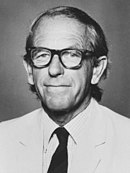Frederick Sanger (13 August 1918 – 19 November 2013) was a British biochemist, the only person to have been awarded the Nobel Prize for Chemistry twice.
He started to research nucleic acid sequencing in the early 1960s. In 1975, he co-invented the "Plus and Minus" technique for sequencing DNA, which could sequence 80 nucleotides at once, a significant improvement on earlier techniques. Using this method, his group sequenced most of the 5,386 nucleotides of φX174 bacteriophage – the first virus and the first DNA genome to be completely sequenced – and showed that some of its genes overlapped. In 1977, he and his group pioneered the Sanger (or dideoxy chain-termination) method for sequencing DNA and used it to sequence the 48,502 bp bacteriophage λ. His technique remained the most widely used sequencing method until the mid-2000s, and was used to generate the first human genome sequence. Sanger is also known for sequencing bovine insulin, the first protein to be sequenced. The Sanger Institute was named for him.
